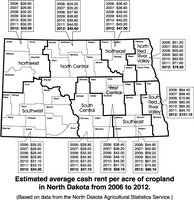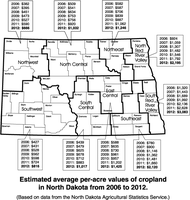N.D. Cropland Values Have Another Strong Year
(Click an image below to view a high-resolution image that can be downloaded)
A January 2012 county survey conducted by the North Dakota office of the National Agricultural Statistics Service confirmed what anyone who has been following the farmland market knew. Cropland had another strong year because values were up about 18 percent statewide.
“By any measure, it has been a historical run for farmland values,” says Andy Swenson, North Dakota State University Extension Service farm management specialist. “Since 2003, cropland values have increased at an average annual rate of about 13 percent, with the sharpest increases occurring since 2007. This surpasses an eight-year period of strong growth in the 1940s. The strongest run up in cropland values during the past 100 years was a nine-year period (1973 through 1981), which averaged 18 percent annually. However, land values then dropped 40 percent from 1981 through 1988. It was 24 years (2005) before values again reached those that were achieved in 1981.”
The prevailing theme fueling land markets since 2007 has been profitable crop production and low interest rates. Strong crop prices and generally strong yields have more than offset spiraling production costs. Another factor is the downside risk to producers. This has been mitigated by the strong prices at which they can insure the crop.
A major concern to the land market is the necessity of continued high crop prices because costs of production have more than doubled in a decade. There also is the risk of higher interest rates and an imminent reduction in government support programs for agriculture.
The largest increase in cropland values (January 2011 to January 2012) was 28 percent in the southeastern region (to $2,120), followed by increases of 22 percent (to $2,195 per acre) in the northern Red River Valley, and 17 to 19 percent for these three regions, east-central region (to $1,425) southern Red River Valley (to $3,083) and the northeastern region (to $1,246). Cropland values increased 15 percent in the south-central region to $1,017. The smallest increases, 12 to 13 percent, occurred in the northwestern region (to $666), southwestern region (to $816) and north-central region (to $1,032).
“The survey indicated that land rents, as typical, did not change as much in percentage as land values,” Swenson says. “On average, cropland rents increased about 6 percent. This was still a strong increase from a historical perspective.”
The largest increase (12 percent) occurred in the south-central region. The average rent is $47.10 per acre. The east-central region increased 8.5 percent to $56.10. It increased 7 percent per acre in the southern Red River Valley to $101.10, northern Red River Valley to $76.50 and southeastern region to $89.10.
Land rent rates in the northwestern region increased 5 percent to $33.50 per acre. The smallest increase, 4 percent per acre, was in the southwestern region to $34.30, north-central region to $45.60 and the northeastern region to $47 per acre.
Swenson cautions that the values and rents are averages for large multicounty regions. Prices can vary considerably within a region because of soil types, drainage and location.
NDSU Agriculture Communication – March 30, 2012
| Source: | Andy Swenson, (701) 231-7379, andrew.swenson@ndsu.edu |
|---|---|
| Editor: | Rich Mattern, (701) 231-6136, richard.mattern@ndsu.edu |
Attachments
- PDF - Estimated average cash rent per acre of cropland in North Dakota from 2006 to 2012. - (55.54296875 kb)
- EPS - Estimated average cash rent per acre of cropland in North Dakota from 2006 to 2012. - (3039.23046875 kb)
- PDF - Estimated average per-acre values of cropland in North Dakota from 2006 to 2012. - (55.759765625 kb)
- EPS - Estimated average per-acre values of cropland in North Dakota from 2006 to 2012. - (2887.1201171875 kb)



